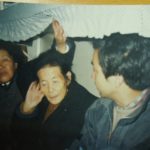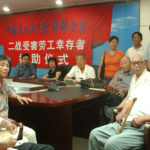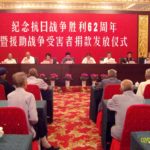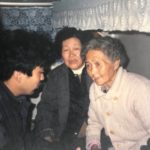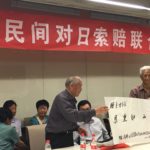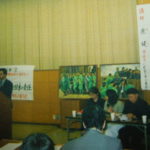This page selects a few recent news that are related to Japanese atrocities in Asia during WWII. Recent news items are listed under the section heading “Related News for Current Release,” and when they are replaced by newer news items, they will be moved to the section heading “Archived Related News.”
The Chinese version has 7 other items on this page; once they are translated, they will be added to the English version.
Related News for Current Release
Settlement Agreement Between Mitsubishi and Chinese Slave Laborers Made Public
A breakthrough occurred on June 1, 2016 on the issue of compensation for former slave laborers who worked for Japanese corporations during WWII. About two and a half years ago, a Chinese court in Beijing accepted lawsuits filed by a group of former slave laborers or their descendants against Mitsubishi, one of the Japanese companies who were involved in the slave labor business during WWII. While these lawsuits are proceeding, Mitsubishi and some of the plaintiffs have been discussing possible out-of-court settlement. On June 1, 2016, it was announced that three plaintiffs have agreed to sign a settlement agreement with Mitsubishi. Since then several more plaintiffs have also signed, and many others are considering it, while some others have decided to continue with the lawsuit.
Before we discuss the main contents of the out-of-court settlement, we want to provide a little more background information on this litigation history. Official documents from Ministry of Foreign Affairs of Japan showed that a total of 38,953 Chinese people, aged from 11 to 78, were captured by the Japanese army and forced to work in at least 35 companies and 135 workplaces in Japan from April 1943 to May 1945. Of these, 3,765 worked as slave laborers for Mitsubishi, and 722 died while working as slave laborers for Mitsubishi. Although many lawsuits were filed in Japan for the Chinese slave laborers, all of them lost, if not at the lower courts, then at the Japanese Supreme Court, with the primary argument that the Chinese government abandoned its right to make such claims when both countries normalized their relationship in 1972. [For more information, see the article “Court acceptance of wartime slavery lawsuit provides hope for survivors” in “Archived Related News Articles.”]
However, as Mr. Tong Zeng pointed out in his 1990 White Paper “China Demands Japan to Compensate Atrocity Victims” 《中国要求日本”受害赔偿”刻不容缓》, in establishing diplomatic relation with Japan in 1972, the Chinese government only agreed that the Chinese government will not seek compensation from Japan related to the atrocities Japan inflicted on China during the 2nd Sino-Japanese War, this does not prohibit the Chinese people from seeking compensation from Japan for the atrocities that they suffered under the hands of the Japanese military. It is because of this difference that the court in Beijing agreed to accept the lawsuits.
The June 1, 2016 Settlement Agreement was made public and published in the August 15, 2016 issue of the China Youth Daily (中国青年报). The Settlement Agreement states:
- Mitsubishi admits the historical truth that the human rights of the thousands of Chinese forced laborers were violated and that over 700 such Chinese forced laborers had died during that period
- Mitsubishi offers its sincere apology to all these forced laborers and its deep mourning to those forced laborers who had perished
- Mitsubishi accepts its responsibility of the above historical truth, and as an expression of apology, offers compensation of 100,000 RMB to each Chinese forced laborer or his beneficiary
- In order to keep this kind of mistake from recurring in the future and to help educate future generations, Mitsubishi will contribute 100 million Japanese yen for the erection of a memorial
- Mitsubishi will also contribute 200 million Japanese yen to investigate and to locate other Chinese forced laborers and their beneficiaries who are currently unaccounted for
- Mitsubishi will pay 250,000 Japanese yen for each Chinese forced laborer or his beneficiary for travel and living expenses to attend a memorial service in Japan
For the complete text of the settlement agreement as published in the August 15, 2016 issue of the China Youth Daily (中国青年报), click “Settlement Agreement.” Also appearing in that issue are two other articles: article by reporter, and article by Mr. Tong Zeng, Chairperson of the Chinese Federation of Civil Claims Against Japan (中国民间对日索赔联合会会长). For a copy of these articles, click Article by Reporter or Article by Tong Zeng.
For a complex issue as the Slave Laborer Settlement Issue that involves so many former slave laborers, their families, and their legal advisers, it is bound to have many different opinions. Therefore, some will accept the current settlement agreement, some will seek another settlement agreement, and some will pursue the lawsuit to the end. It does not necessarily mean that some people are right, and some people are wrong. We respect the plaintiffs who signed the current Settlement Agreement. We also respect the plaintiffs who continue to pursue the lawsuit against Mitsubishi.
But we all should work toward the ultimate goal of getting the Japanese government to acknowledge, apologize, and compensate the victims or their beneficiaries for the large scale and inhumane atrocities her military committed against the Chinese people during the Second Sino-Japanese War.
Archived Related News
-
- Japanese Medical School Museum Exhibits Vivisection Display on American POWs:(The Japan Time News, 04-04-2015):
The Kyushu University in Fukuoka recently displayed an exhibit of vivisection (operation on live humans without anesthesia) on American POWs in their new medical history museum. These are documents in their possession for decades, but never publicly revealed. The vivisection victims were 8 American airmen shot down in 1945 from an American B-29 bomber. They were captured as POWs, and then were vivisected by the Japanese doctors at this medical school. The doctors killed the American POWs by injecting diluted seawater into their veins, removing their lungs or livers and performing other horrific experiments on their bodies to test their limits. To read more, click here

Kyushu University’s medical history museum, which opened Saturday,April 4, 2015,on campus in Fukuoka, is facing the school’s dark wartime past by displaying items about the live dissections of U.S. prisoners
-
- Exhibit on “War and Medicine” at the 27th General Assembly of The Japan Medical Congress in Osaka in 2007 :
This exhibit by a segment of the Japan Medical Congress in 2007 reflects on the morality of Japanese medicine as practiced by Japan’s biological/chemical warfare research centers and factories, such as Unit 731, during the 2nd Sino-Japanese War (1931-1945). It is a large exhibit and document of over 120 pages containing a large amount of important information in Japan’s possession but seldom revealed to the public. To read more, clickhere
-
- Historians Urge Japan to Set War Record Straight:(The Wall Street Journal: May 7, 2015) :
Nearly 200 Western historians have called on Prime Minister Shinzo Abe’s government to address Japan’s history of colonial rule and wartime aggression, in a clear rebuke of a leader who has clashed with neighbors over historical issues.
Among the 187 historians were John Dower, emeritus professor at the Massachusetts Institute of Technology; Herbert Bix, emeritus professor at Binghamton University; and Ezra Vogel, a Harvard historian. Mr. Dower and Mr. Bix wrote “Embracing Defeat” and “Hirohito and the Making of Modern Japan,” respectively. Both books won the Pulitzer Prize and are considered required reading for those studying Japan’s modern history.
To read more,click here
-
- Court Acceptance of Wartime Slavery Lawsuit Provides Hope for Survivors(Global Times, 03-23-2014):
Zhang Shijie, 88, gave a sigh of relief when his son Zhang Yang told him a Beijing court had accepted a lawsuit against two Japanese firms who forced him and another 37 Chinese people to work as free labor during World War II. “I finally have something to look forward to,” he said. To read more, click here
-
- U.S. Historians Slam Abe Effort to Change Textbook Dealing with “Comfort women”(The Japan Times News, 02-09-2015):
Nineteen U.S.-based historians have protested attempts by Prime Minister Shinzo Abe and his administration to suppress statements in U.S. and Japanese history textbooks about the “comfort women” who suffered under a brutal system of sexual exploitation during World War II. … In November, the Foreign Ministry told the Japanese Consulate in New York to ask publisher McGraw-Hill for changes in “Traditions and Encounters: A Global Perspective on the Past,” its world history school textbook co-authored by historians Herbert Ziegler and Jerry Bentley. … McGraw-Hill rejected the ministry’s request, saying that the scholars are aligned behind the historical facts of the issue. To read more, click here
-
- Netherland’s Foundation of Japanese Honorary Debts’ Statement on Recent Beheadings of Japanese Hostages and Actions of Japanese Military during WWII (02-10-2015 Petition letter #243 to Prime Minister Shinzo Abe):
“…Many of the surviving Dutch from Dutch East Indies had comparable experiences. Japan has a history of similar military terror whilst occupying and colonizing South East Asia. During that period public beheading was part of their barbaric rule. The Japanese military had no mercy during their regime of terror and abuse. … The fact that the Japanese government still denies any responsibility for these criminal acts during World War II, leaving the victim families behind without condolences and sympathy, makes it even harder to forgive let alone to forget.”
To read the whole Petition letter, click here.
In addition, to see all the other Petition letters and the mission of the organization, please click: http://www.japanse-ereschulden.nl/category/petities/ .




